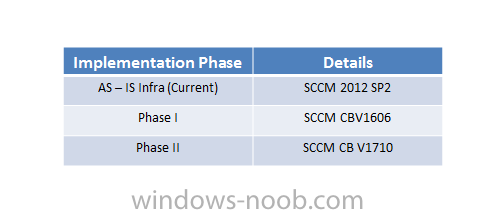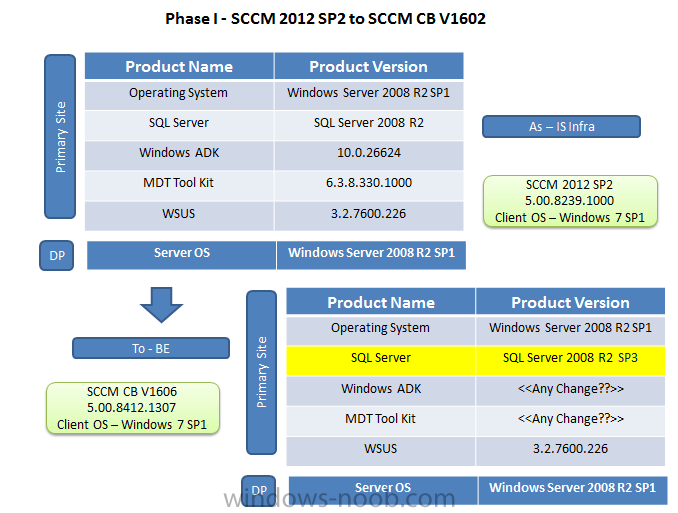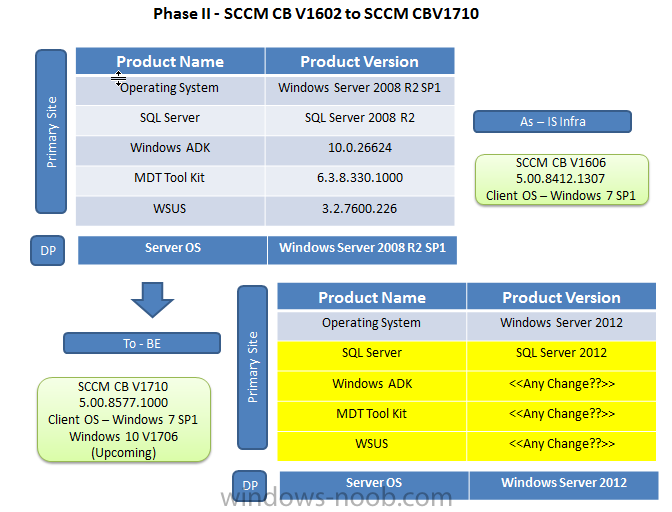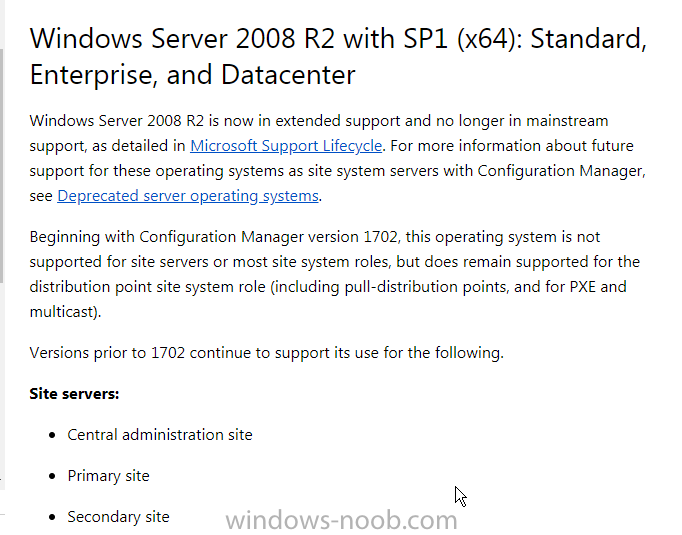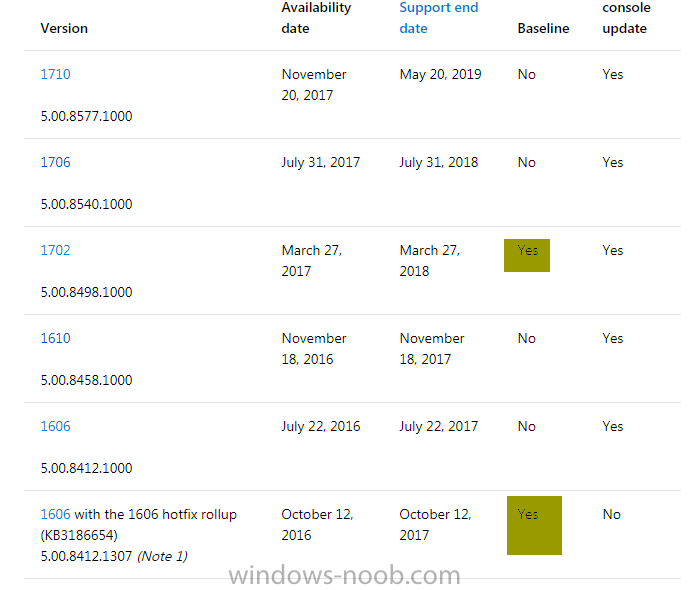
Veera
Established Members-
Posts
31 -
Joined
-
Last visited
Everything posted by Veera
-
SCCM CB - DP, MP with High Availablity
Veera replied to Veera's topic in System Center Configuration Manager (Current Branch)
Great, Thank You We are Preferred to use the SQL Always ON Basic as HA- 8 replies
-
- sccm
- current branch
-
(and 8 more)
Tagged with:
-
SCCM CB - DP, MP with High Availablity
Veera replied to Veera's topic in System Center Configuration Manager (Current Branch)
WE do not have money to pay for SQL (Available Always AS ON). Only SQL 2017 Management Studio as STANDARD- 8 replies
-
- sccm
- current branch
-
(and 8 more)
Tagged with:
-
SCCM CB - DP, MP with High Availablity
Veera replied to Veera's topic in System Center Configuration Manager (Current Branch)
I have Plan to reduce the Workload of CPU Hence the minimum plan is to have SERVER A - Primary Site with SQL (Primary Site will be having SCCM Site Server Roles) SERVER B - All Client Facing Role So that, the CPU Utilization can be reduced accordingly.- 8 replies
-
- sccm
- current branch
-
(and 8 more)
Tagged with:
-
Dear Experts, I Would like to get some inputs from you Please. My Data Center is located in 2 Regions. This data center is supplying the services (Windows Server, Network., etc) At Present we are planning to perform SCCM CB Implementation with High Availability for SCCM Client Roles. In fact not for SQL (Due to Commercial items) Single Standalone Primary Site is fair enough for the environment. However, We would like to reduce the usage of SQL Server, and make the Client facing roles with HA. Hence your inputs would be helpful for us Data Center Region A: Server 1 - SCCM Site Server - A Primary Site with Roles (Component Server, Site Server, Site System, Reporting Service Point, Other Non Client Facing Roles) Server 2 - SCCM Site System - Client Facing Roles (Management Point, Software Update Point/WSUS, Distribution Point (With WDS/PXE OSD Capabilties) Data Center Region B: Server 3 - SCCM Site System - Client Facing Roles (Management Point, Software Update Point/WSUS, Distribution Point (WithOut WDS/PXE OSD Capabilties) So all Client facing role, will be working with HA Option. However, PXE Boot for OSD will work only with SERVER 2 from WDS (Which respond to the Client during the OS Imaging) - To make this happen I need to mention the IP Details of WDS Server (Server 2 from Region A) in the DHCP Scope. Am I correct? The reason, I do not preferred to give the SERVER 3 (From Region B)as WDS Role with PXE, which we do not need to give the multiple entries with DHCP Scope (Option 66, 67) for OSD Please suggest, if this is looks good for an organization. The Ultimate goal is to reduce the SQL CPU Utilization.
- 8 replies
-
- sccm
- current branch
-
(and 8 more)
Tagged with:
-
SCCM CB - Windows 10 ADK
Veera replied to Veera's topic in System Center Configuration Manager (Current Branch)
Thank You for your support.. -
SCCM CB - Windows 10 ADK
Veera replied to Veera's topic in System Center Configuration Manager (Current Branch)
You are rite. My Requirement here : With new Server (SCCM CB) we will be using it for Both Windows 7 and Windows 10. Windows 10 for sure, will be going with most recent release (V 1803..) We may still have many OS imaging with Windows 7 as well., also win 7 to win 10 upgrade. If I use, SCCM CB V1710 - I can Perform both OS Imaging *Win 7 and Win 10* Rite. In fact, We are using the boot image (Custom made) -
Dear Experts, I Would like to take an advice from you all for ADK are talking about ADK: Would like to get few points here At Present, I am having SCCM 2012 SP2 with Windows 7 with ADK *10.0.0.26624* Assume the Site Code : ABC Now the Plan is to do side by Side migration with SCCM CB V1702 and Upgrade to SCCM CB V1710 and this is to support Windows 10. Site Code : DEF Before I install windows 10, I will be moving all the clients from Site Code : ABC to DEF I will be having all my Existing Client move from *Windows 7 Machines* to DEF Site In the New Environment, Will be Managing both windows 7 and windows 10 1. Application Management (Windows 7 and Windows 10) 2. Patch Management *Windows 7, 10* 3. OS Imaging *Windows 7, Windows 10* I Would like to make my environment to be stable with both OS. Please let me know which ADK Version is needed in my Environment for Windows 10 Operating System I Will be having 1. Windows 10 LTSB 2. Windows 10 Enterprise With Version 1803 3. Also Windows 7 SP1 Which ADK Version, I Should have in my Environment *DEF Site Code* After all successful, Migration will be moving out completely from the Site Code : ABC
-
Dear Experts, Very Shortly - I will be having SCCM CB in my environment. I would like to get an advice/inputs from you to perform the Windows 10 Deployment Scenario's. Would like to get an advice, what are the topics - I should cover for Windows 10 Readiness with SCCM CB Environment My Organization preferred to perform the Management in the same way which I am doing for Windows 7. However, I would like to give some value added proposal's Any recommendations from you Experts?
-
Dear Admin, Sorry if any questions are wrong. I have been managing SCCM - But this Migration is 1st time, that we are doing which the existing version installed by 3rd Party PPL. Hence, it is require to get some advice from experts like you. At Present, Upgrade seems to be more complicated with lengthy process. Hence, it is Planned to Install Complete New Environment with Existing Production DC (With Different Site Code) I hope, We can have Multiple Environment of SCCM with in the same container (System Management), However the Site Code/Server Name should not be the same. Is that Correct? So the Plan as follows: 1. Performing the SCCM CB Environment 2. Slowly moving all Clients from One Domain to Other Domain. Current Infrastructure: SCCM 2012 SP2 with Windows 7 Clients (Managing – Application, Patch, Operating System Deployment) This is running on Windows Server 2008 with SQL 2008 Required Infrastructure: It is required to Manage Windows 10 Clients, Windows 7 Operating System (Application, Patch, OS Deployment) After being and hearing more responses from our Engineer’s/Experts. It is planned to progress the Green Field Implementation 1. Windows Server 2016 2. SQL Server 2014 or SQL Server 2016 3. Windows 10 ADK with Version ADK 1709 - 10.1.16299 4. System Center Configuration Manager V1710 New Implementation along with Distribution Point 5. Making the Environment with Complete Readiness for all Application Source, OSD Task Sequences, Software Updates., etc., This New Infra will be completely ready with supporting all contents. IP Assignment: We are already having the Boundary Groups, which is based on the IP Range with Region wise in the OLD Environment. New Environment – Client Movement from Old Infrastructure: Let us consider we have the IP Range called 192.168.1.1 to 192.168.1.254 is active and supplying the service with Windows 7 Client OS on Old Infrastructure (SCCM 2012 SP2) Now, the New Infrastructure is ready with all sources (SCCM CB V1710) – If the Client IP Range, Boundary Settings for Site assignment is getting moved from Old Infra to New Infra By Using Automatic Site Client Push Installation 1. SCCM Agent Will get install/upgrade with Version CBV1710 2. Since the IP Range, Boundary Group is allocated with New Environment All the Deployments will get started to run on new Environment. By performing this activity 1. All Windows 7 Clients will be running with SCCM CBV1710 Agent Version 2. All Windows 7 Clients will be reporting to SCCM CBV1710 Infrastructure 3. Slowly, I can prepare myself for Windows 10 Upgrade Projects. Hence, it is require to have 2 Environments in the Same System Management Container (SCCM 2012 SP2, and SCCM CB V1710). If I hold the 2 Environment with Different Site code and host name, Will that be Okay.. Please Advice!! My Sincere apologize to send the details, Personally.
- 17 replies
-
- current branch
- sccm cb
- (and 7 more)
-
Dear Experts, I would like to get an advice from you Please. You may see multiple forums from me – As my Environment is bit complicated. Environment implemented by 3rd party and handover to us as part of transformation – Which we are struggling to upgrade or proceed further. Current Infrastructure: SCCM 2012 SP2 with Windows 7 Clients (Managing – Application, Patch, Operating System Deployment) This is running on Windows Server 2008 with SQL 2008 Required Infrastructure: It is required to Manage Windows 10 Clients, Windows 7 Operating System (Application, Patch, OS Deployment) After being and hearing more responses from our Engineer’s/Experts. It is planned to progress the Green Field Implementation 1. Windows Server 2016 2. SQL Server 2014 or SQL Server 2016 3. Windows 10 ADK with Version ADK 1709 - 10.1.16299 4. System Center Configuration Manager V1710 New Implementation along with Distribution Point 5. Making the Environment with Complete Readiness for all Application Source, OSD Task Sequences, Software Updates., etc., This New Infra will be completely ready with supporting all contents. IP Assignment: We are already having the Boundary Groups, which is based on the IP Range with Region wise in the OLD Environment. New Environment – Client Movement from Old Infrastructure: Let us consider we have the IP Range called 192.168.1.1 to 192.168.1.254 is active and supplying the service with Windows 7 Client OS on Old Infrastructure (SCCM 2012 SP2) Now, the New Infrastructure is ready with all sources (SCCM CB V1710) – If the Client IP Range, Boundary Settings for Site assignment is getting moved from Old Infra to New Infra By Using Automatic Site Client Push Installation 1. SCCM Agent Will get install/upgrade with Version CBV1710 2. Since the IP Range, Boundary Group is allocated with New Environment All the Deployments will get started to run on new Environment. By performing this activity 1. All Windows 7 Clients will be running with SCCM CBV1710 Agent Version 2. All Windows 7 Clients will be reporting to SCCM CBV1710 Infrastructure 3. Slowly, I can prepare myself for Windows 10 Upgrade Projects. Hence, it is require to have 2 Environments in the Same System Management Container (SCCM 2012 SP2, and SCCM CB V1710). If I hold the 2 Environment with Different Site code and host name, Will that be Okay.. Please Advice!! My Sincere apologize to have separate post. Earlier was discussed for the Migration (With in the same server)., but now we preferred to install the SCCM CB V1710 Infra with new server *Windows 2016 & SQL 2016 * and move all the Clients to the new Infrastructure.
-
- system management container
- sccm cb
- (and 7 more)
-
Dear Admin, However, Will be performing the Green Field Implementation of SCCM CB on Existing PROD Domain Controller. If I am using Different Site code, Different Host Name for SCCM CB - Is that makes any impact on Existing System Management Container Please.
- 17 replies
-
- current branch
- sccm cb
- (and 7 more)
-
Absolutely, You are rite. Based on your approach, rather than going with Migration, can go for the new implementation and also manage both OS Versions (Windows 7 and Windows 10) Slightly, I can move all the Existing Clients from Old Infrastructure to New Infrastructure I will also think in this aspect. AS-Infra: SCCM 2012 SP2 with OSD, Application Deployment, Patch Management for Windows 7 SP1. With Single Standalone Primary Site and SQL On Same Server SCCM 2012 SP2 is installed with Windows Server 2008 SP1 STD and SQL 2008 STD Windows 10 ADK - 10.0.26624 Distribution Points - 20 + Across All location With Windows Server 2008 SP1 Standard SCCM Infra Site Code : 123 To-BE Infra: Single Standalone Primary Site with Operating System - Windows Server 2016 SQL Server - SQL Server 2014 SP2 ADK - Windows 10 ADK to Support (Version : 10.1.162990) for Windows 10 V1709 Environment System Center Configuration Manager Baseline Version - SCCM CB V1710 (Site Code : 456) Now, I will be having the Infrastructure with SCCM 2012 SP2 (Which is supporting for Windows 7) and SCCM CB V1709 (To Support both Windows 7 and Windows 10 Operating System) Let us assume that, Do I get chance to move all the Clients from SCCM 2012 SP2 to SCCM CB V1710 (Which is from Site Code: 123 to 456) Based on this, I can migrate all the Existing Windows 7 Client Operating System (Site Code : 123 to New Infra Site Code : 456) I can use the Option "Client Push Installation" account and also the Boundary Group for Site Assignment. Do you think, Is this Okay?
- 7 replies
-
- system center configuration manager
- sccm 2012
- (and 7 more)
-
Dear Garth, It is because of internal Political reason that I do not have option to upgrade the OS and SQL at this Point of time. However, If you Validate my Steps., as follows (Will be helpful) Also Requesting you to add if any items/missing from my end. As - IS Infra: SCCM 2012 SP2 with OSD, Application Deployment, Patch Management for Windows 7 SP1. With Single Standalone Primary Site and SQL On Same Server SCCM 2012 SP2 is installed with Windows Server 2008 SP1 STD and SQL 2008 STD Windows 10 ADK - 10.0.26624 Distribution Points - 20 + Across All location With Windows Server 2008 SP1 Standard Planned Infra: We are looking further to upgrade the Operating System (Client OS) from Windows 7 to Windows 10 V1709 In order to that, We need to upgrade the SCCM Infrastructure. Hence, As per the Plan Phase I: SCCM 2012 SP2 to SCCM CB V1606 Steps : 1. Retaining Windows Server 2008 On Primary Site and DP's 2. Performing SQL SP3 Update on SQL 2008 STD 3. Performing SCCM Upgrade from SCCM 2012 SP2 to SCCM CB V1606 using Baseline version 4.Installation of SCCM Client on all end Points Now the Infrastructure will be upgraded from SCCM 2012 SP2 to SCCM CB V1606 As per the Plan Phase II: (This is to Support both Windows 7 and Windows 10 V1709 Client Operating System) SCCM CB V1606 to SCCM CB V1710 1. Upgrading the Primary Site Operating System from Windows Server 2008 SP1 to Windows Server 2012 2. Upgrading the SQL Server from SQL 2008 SP3 to SQL 2012 SP4 3. Uninstalling the OLD Windows 10 ADK and Install the new Windows 10 ADK (10.1.16299) 4. Uninstalling the WSUS/SUP Role and Reinstalling it again on Windows Server 2012 5. Running the CB Upgrade from SCCM CBV1606 to CBV1710 6. Installing SCCM Client CB V1710 on Windows 7 SP1 Computers 7. Preparation of Windows 10 Operating System in the Environment Finally the Infrastructure with Windows 7 and Windows 10 OS, for Application Management, Patch Management, OS Deployment, Imaging., etc., I Would like to get the inputs from you Please.
- 7 replies
-
- system center configuration manager
- sccm 2012
- (and 7 more)
-
My Apologize, Let me Explain.. As - IS Infra: SCCM 2012 SP2 with OSD, Application Deployment, Patch Management for Windows 7 SP1. With Single Standalone Primary Site and SQL On Same Server SCCM 2012 SP2 is installed with Windows Server 2008 SP1 STD and SQL 2008 STD Windows 10 ADK - 10.0.26624 Distribution Points - 20 + Across All location With Windows Server 2008 SP1 Standard Planned Infra: We are looking further to upgrade the Operating System (Client OS) from Windows 7 to Windows 10 V1709 In order to that, We need to upgrade the SCCM Infrastructure. Hence, As per the Plan Phase I: SCCM 2012 SP2 to SCCM CB V1606 Steps : 1. Retaining Windows Server 2008 On Primary Site and DP's 2. Performing SQL SP3 Update on SQL 2008 STD 3. Performing SCCM Upgrade from SCCM 2012 SP2 to SCCM CB V1606 using Baseline version 4.Installation of SCCM Client on all end Points Now the Infrastructure will be upgraded from SCCM 2012 SP2 to SCCM CB V1606 As per the Plan Phase II: (This is to Support both Windows 7 and Windows 10 V1709 Client Operating System) SCCM CB V1606 to SCCM CB V1710 1. Upgrading the Primary Site Operating System from Windows Server 2008 SP1 to Windows Server 2012 2. Upgrading the SQL Server from SQL 2008 SP3 to SQL 2012 SP4 3. Uninstalling the OLD Windows 10 ADK and Install the new Windows 10 ADK (10.1.16299) 4. Uninstalling the WSUS/SUP Role and Reinstalling it again on Windows Server 2012 5. Running the CB Upgrade from SCCM CBV1606 to CBV1710 6. Installing SCCM Client CB V1710 on Windows 7 SP1 Computers 7. Preparation of Windows 10 Operating System in the Environment Finally the Infrastructure with Windows 7 and Windows 10 OS, for Application Management, Patch Management, OS Deployment, Imaging., etc., I Would like to get the inputs from you Please.
- 7 replies
-
- system center configuration manager
- sccm 2012
- (and 7 more)
-
- 7 replies
-
- system center configuration manager
- sccm 2012
- (and 7 more)
-
Dear Admin, My Apologize - I feel to raise this Question separately to make myself clarity on asking question and getting answer, As per the previous post, Phase I : Upgrade from SCCM 2012 SP2 to SCCM CB V1606 At Present, the Environment is having as below and mentioned with To - BE State After Successful, Completion with Phase I - Progressing Phase II as follows (As-IS and To-BE Infra) Please Validate if the As-IS to Phase I, II (To-BE) is Okay / Please suggest if any changes Kindly suggest me, My Sincere sorry if there is any repeated questions. I feel to get some added advice from you for MDT, ADK. At Present, We are using AS-IS Infra (SCCM 2012 SP2) with Operating System Windows 7 SP1 1. Application Deployment 2. Patch Deployment 3. OS Deployment *With Windows 7 SP1* We Continue with the same for all 3 above, and added to that Windows 10 OS as well with New Infra (Phase II SCCM CB V1710) Looking for your response and mentorship Regards, Veera
- 7 replies
-
- system center configuration manager
- sccm 2012
- (and 7 more)
-
Yes Admin, Thank You again, for your great efforts and educating me. Do you think, any other area that I need to focus. With Regards to HW Sizing., On VM AS-IS Infra SCCM 2012 SP2 (5.00.8239.1000) Pre Requisite's: Processor 4, Core 8, RAM 32 GB Windows Server 2008 R2 STD (Version 6.1/Winver 7600 SP1) SQL 2008 R2 SP1 (10.50.2811) MDT (6.3.8330.1000) ADK (10.0.26624) SCUP 2011 (5.00.1727.0000) TO-BE Infra with Phase I from SCCM 2012 SP2 to SCCM CB V1606 Processor 4, Core 8, RAM 32 GB Windows Server 2008 R2 STD (Version 6.1/Winver 7600 SP1) SQL 2008 R2 SP1 (10.50.2811) Retaining the DP (With Same Server Level as Windows Server 2008 R2 SP1) ADK - Do we need to upgrade << Please suggest >> SCUP - Do we need to upgrade << Please suggest >> Running the System Center Upgrade Configuration Manger V1606 using Baseline Version, and Upgrade via System Center Console using Service Connection Point Role. 1. Upgrading the Primary Site 2. Upgrading the DP's 3. Upgrading the Client TO-BE Infra with Phase II from SCCM CB V1606 to SCCM CB V1710 Pre Requisite's: Processor 4, Core 8, RAM 32 GB to Processor 8, Core 16, RAM 64 GB Windows Server 2008 R2 STD (Version 6.1/Winver 7600 SP1) to Windows Server 2012 SP1 (Standard Edition) SQL 2008 R2 SP1 (10.50.2811) to SQL 2012 Standard Edition ADK - Do we need to upgrade << Please suggest >> SCUP - Do we need to upgrade << Please suggest >> Using Service Connection Point Role, Upgrade from SCCM CB V1606 to SCCM CB V1702 and So On. 1. Upgrading the Primary Site 2. Upgrading the DP's 3. Upgrading the Client With this, I can still manage my existing Windows 7 Clients, and also can upgrade to Windows 10 Client and Windows 10 Management (Complete Life Cycle Environment)
- 17 replies
-
- current branch
- sccm cb
- (and 7 more)
-
Thank You Admin, But my Current Infra is running with Windows Server 2008 R2 along with SQL 2008 R2 as Single Standalone Primary Site with 20+ DP. All Distribution Points are running with Windows Server 2008 R2 STD. So, I believe the Upgrade Windows Server and SQL Server is needed to reach SCCM CBV1710 from SCCM 2012 SP2. However, We Preferred to retain the Version of Windows Server 2008 R2 STD for all Distribution Points https://docs.microsoft.com/en-us/sccm/core/plan-design/configs/supported-operating-systems-for-site-system-servers Please suggest..
- 17 replies
-
- current branch
- sccm cb
- (and 7 more)
-
Dear Admin, This is the final Approach, Which is planned based on the recommendations/suggestions from MS Tech-net Forums. However, feel to get advice from you, before progressing. As I am having WS 2008 R2 STD with SQL 2008 R2 STD, Will upgrade to SCCM CB V1606 as per the recommendations. (SCCM 2012 SP2 to SCCM CB V1606 Using Baseline0 After Completing, the SCCM CB V1606 Upgrade, Will upgrade Operating System, SQL, CB V1606 to Possible Version, DP Upgrade and Client upgrade. All this is to Satisfy my environment to equip to Windows 10 OS Deployment, Upgrade, Windows 10 Life Cycle Management (Windows 10 V1709) Please Suggest...
- 17 replies
-
- current branch
- sccm cb
- (and 7 more)
-
By Referring the following. Is that upgrade is Possible from SCCM 2012 SP2 to SCCM CB V1606 (With Windows Server 2008 R2 + SQL 2008 R2 STD) Windows SERVER 2008 Upgrade to Windows Server 2012 SQL 2008 STD upgrade to SQL 2012 SCCM CB V1606, Upgrade to SCCM CB V1702 After that using Service Connection Point further upgrade's. Is this Okay? https://docs.microsoft.com/en-us/sccm/core/servers/manage/updates
- 17 replies
-
- current branch
- sccm cb
- (and 7 more)
-
Dear Admin, I Understand now, that as per my Infra It is required to upgrade my SCCM Environment to SCCM CB V1602 as Intial Level Then I must upgrade the Operating System from Windows Server 2008 to Windows Server 2012, SQL upgrade using https://docs.microsoft.com/en-us/sccm/core/servers/manage/upgrade-on-premises-infrastructure#bkmk_from2008r2 Then, I must Upgrade the Configuration Manager CB V1602 to V1702 and So on. My Question now: If the Current Branch is upgraded to CB V1602 from SCCM 2012 SP2? If I Install the Role called SERVICE CONNECTION POINT With that help of Service Connection Point? DO I get chance to upgrade from SCCM CB V1602 to V1702 Or Do I need to download the Copy of SCCM CB V1702 ISO File and Install it (For Upgrade). Please Suggest?
- 17 replies
-
- current branch
- sccm cb
- (and 7 more)
-
Dear Admin, Thank You again for your teachings. Please, let me know - Am I giving the correct plan and Please correct me If I Wrong. 1. At Present the Infrastructure is with Windows Server 2008 R2 Standard (Included with SQL 2008 R2 Standard) with 22 DP's (Windows Server 2008 R2 Standard) with SCCM 2012 SP2 for Supporting 5000 + Clients 2. At Present, We are looking forward to upgrade the SCCM Environment to Current Branch. The reason for upgrading to Current Branch is to support the Windows 10 Operating System upgrade and deployment. 3. If it is Windows 10 Operating System, the Possible upgrade is needed with SCCM CB V1702 for Supporting Windows 10 Clients with Version 1709 Hence, We have Plan to upgrade the Operating System, SQL Upgrade. However, As per your article - It is Referred by you... 1. I need to upgrade the Configuration Manager upgrade from SCCM 2012 SP2 to SCCM 2012 Version 1602 2. Then, I need to upgrade the Operating System from Windows Server 2008 R2 to Windows Server 2012 R2 *Along with SQL upgrade from SQL 2008 R2 to SQL 2012* 3. Once the upgrade is completed, Need to upgrade the Configuration Manager from Version 1602 to V1702 and So on.. Am I correct? Earlier, I have Posted the Query on MS Article, got confused. I Would request you to guide me the upgrade approach based on my Infrastructure. So that, I will progress in TEST Environment and move to PROD. Please forgive if any silly questions Regards, Veera
- 17 replies
-
- current branch
- sccm cb
- (and 7 more)
-
Dear Admin, I Would like to hear some additional feedback from you on this. Currently my infrastructure is having the following Windows Server 2008 R2 - AD + DNS Windows Server 2008 R2 - DHCP Windows Server 2008 R2 - SCCM 2012 SP2 (5.00.8239.1000) with SQL 2008 R2 Standard, with 21 DP's *All DP's are Windows Server 2008 R2 Standard* My Windows Team is not aware of the status of Schema Level or OS Patch Level. So they are not looking or allowing me to install the SCCM on Test Environment to Upgrade from (SCCM 2012 SP2 to SCCM CB V1702) Hence the possible approach arrived for Testing as follows: 1. With help of Network - Creating an isolated Subnet, VLAN in the Data Center Level 2. AD + DNS, DHCP, SCCM Primary Site (Clone, and getting moved with in the Isolated subnet VLAN Range) 3. The Test Environment will be also having few Clients (Which is with in the isolated subnet) 4.Upgrade activity starts with Windows SERVER 2008 to 2012, SQL 2008 to SQL 2012, Upgrade the SCCM 2012 SP2 to SCCM CB V1702, TEST DP Upgrade on one of the Remote Site (With in the Same IP Subnet Range) 5. Install Client *Client Upgrade from SCCM 2012 SP2 to SCCM 2012 CB V1702* Based on the Testing and Validation, We will perform the activity on PROD Any feedback/inputs from you Please...
- 17 replies
-
- current branch
- sccm cb
- (and 7 more)
-
Dear Admin, I feel so happy to receive your response. You are the real helping person for many people like me. No one forget your post/materials..:) Regarding my environment: I do not get chance to create new AD, DNS in my Environment. So Preferred to use the PROD Domain Controller. However, the following plan is in my check list. Happy to adopt your idea if you feel the following is not good..Please advice. 1. Creating Separate TEST service account for all Installation activities 2. Creating Sepereate Test AD Security Group's 3. Assigning the System Management Container - Delegate Permission for the TEST AD Security Group Only. In PROD We are having the Site Code as OLY, and plan to use the Site code as PPT or DEV for Test Environment 4. During the Boundary group creation, will not use the option use this boundary group for Site assignment If this Precautions made, Is this Okay. I Would like to follow your advice..:)
- 17 replies
-
- current branch
- sccm cb
- (and 7 more)


